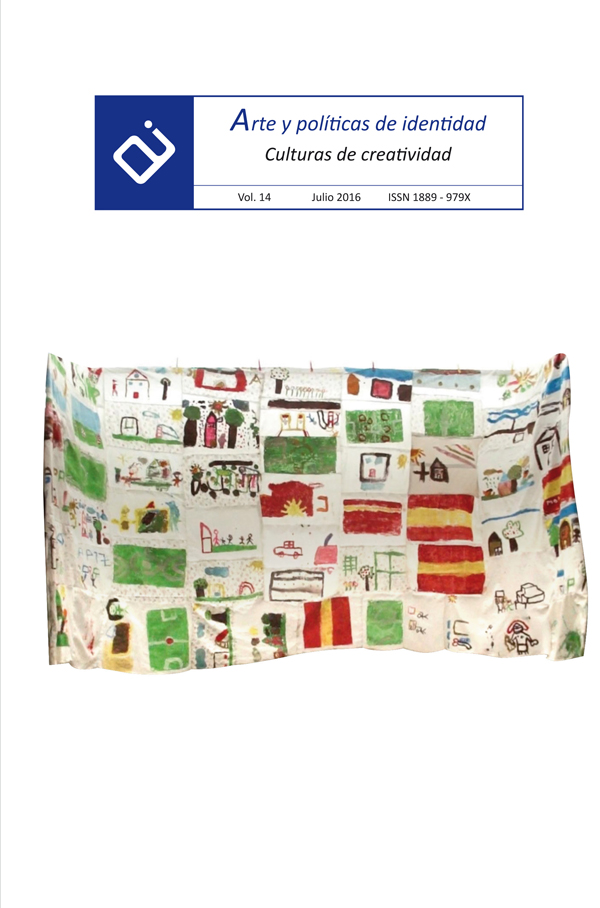Contributions from the Techne to the Teaching Approach in Secondary and High School.
Abstract
The aim of this article is to analyse some of the aspects of our secondary and high school education that determine the prevalent current pedagogic situation, such as the working dynamics or the relationship between the learning process and its results, and how they could be improved. Based on both the working methods observed and the experience gained during my internship at Ibarrekolanda High School of Performing Arts, Music and Dance, I present the thesis that art methodologies can enrich learning processes of formal education. Diverse art techniques allow us developing skills to deal with issues and tackle problems that arise in creative processes and life. This paper framed in the field of formal education is based on non-formal education experiences. Whereas structures of educational institutions define pre-established objectives and results, in western artistic contexts artists have launched during the last decades transmission programs in order to promote open processes. The working methods and relations used in these programs are convenient and applicable at secondary school. Some of the factors that sustain the change artistry leads on secondary education and high school are diversity of solutions and results, acceptance of particularities, weakness and dullness, close attention to relations and qualities, more comprehensive relationship between educators and students, and among students themselves, interaction and movement of freer bodies and identification with school.Downloads
-
Abstract567
-
PDF (Español (España))444
References
Aláez, A.L. (2008). Pabellón de Escultura / Sculpture Pavillion.Dossier de la exposición. León: MUSAC.
Almaraz, Á. (2015). Entrevista. 24/04/2015.
Alumnos IES Ibarrekolanda (2015). Diez entrevistas. 20-22/04/2015.
Astiz, I. (13 de agosto de 2014). Konplizitatea lan metodo gisa. Itziar Okariz y Jon Mikel Euba. Berria. Recuperado de http://www.berria.eus/paperekoa/1859/022/001/2014-08-13/konplizitatea_lan_metodo_gisa.htm
Badiola, T., Eraso, X., Etchebarria, G., Imaz, I. y Mitxelena, P.(2000). Enseñanza del arte hoy en día. Mesa redonda. Zehar, 42, 4-7. Recuperado de http://www.old.arteleku.net/arteleku/publicaciones/editorial/zehar/42-ensenanza-del-arte/ensenanza-del-arte-hoy-en-dia.-mesa-redonda.-txomin-badiola-xanti-eraso-guadalupe-etchebarria-inaki-imaz-y-peio-mitxelena?set_language=eu
Badiola, T. (2006). Hay veces en las que uno tiene que poner en escena su propio fracaso. Rêve sans fin (la técnica) texto escrito para la exposición. Madrid: Galería Soledad Lorenzo. http://www.soledadlorenzo.com/artistas_entrada/badiola/expos.html
Badiola,T., Euba, J.M. y Prego, S. (2012). Primer Proforma. Barcelona: Actar.
Badiola, T., Euba,U.M., Prego, S., y Pérez Rubio, A. (2013). La exposición como proceso. En torno a Primer Proforma. Audio de la charla presentación del libro. Madrid: MNCARS. Recuperado de http://www.museoreinasofia.es/multimedia/exposicion-como-proceso-torno-primer-proforma
Brea, U. (2004). Entrevista a Txomin Badiolari. Euskonews. Recuperado de http://www.euskonews.com/0271zbk/elkar_es.html
Camnitzer, L. (2015). Arte y pedagogía. Esferapública. Recuperado de http://esferapublica.org/nfblog/arte-y-pedagogia/
Eisner, E. (2004). ¿Qué puede aprender la educación de las artes?. México: SEP/DGTVE. Recuperado de https://www.youtube.com/watch?v=4R6rasalOZ0
Eisner, E. (2007). Cognición y curriculum: una visión nueva. Buenos Aires: Amorrortu.
Esnaola, M. (5 de enero de 2015). El arte es la actividad más solitaria y más colectiva que existe. Entrevista a Txomin Badiola. Deia. Recuperado de http://www.deia.com/2015/06/05/ocio-y-cultura/cultura/el-arte-es-la-actividad-mas-solitaria-y-mas-colectiva-que-existe
Gimeno Sacristán, J. (1988). La pedagogía por objetivos: Obsesión por la eficiencia. Madrid: Morata.
Grotowsky, J. (1974). Hacia un teatro pobre. México: Siglo XXI.
Kalostra. (s.f.). Recuperado dehttp://www.kalostra.eus/ .
Katz, V. y Museo Nacional Centro de Arte Reina Sofía. (2002). Black mountain college: Una aventura americana. Catálogo de la exposición. Madrid: MNCARS.
Imaz, I. y Mitxelena, P. (2000). Construir la intermediación. Ser artista. Zehar, 42, 22-27. Recuperado de http://dialnet.unirioja.es/servlet/articulo?codigo=2855263
Okariz, I. (2013). Capítulo 2VW. Presentación dentro de lasJornadas Arte ekoizpen feministak: ezagutza prozesuak eta belaunaldien arteko harremanak. Arteleku. Recuperado de https://vimeo.com/87561448
Richards, T. (2005). Trabajar con Grotowski sobre las acciones físicas. Barcelona: Alba.
Warhol, A. (2008). Mi filosofía de A a B y de B a A. Barcelona: Tusquets.
Wick, R. (1988). Pedagogía de la Bauhaus. Madrid: Alianza.
Works published in this journal are subject to the following terms:
- The Service of Publications from the University of Murcia (publishing house) keeps the published works’ copyrights, and favors and allows the reuse of these works under the license indicated in point 2.
- Works are published in the journal’s online edition under the license Creative Commons Reconocimiento-NoComercial-SinObraDerivada 3.0 España(texto legal). They can be copied, used, disseminated, transmitted and publicly exhibited, as long as: i) the author and original source of publication are cited (journal, publishing house and work’s URL); ii) they are not used for commercial purposes; iii) the existence and specifications of this license are mentioned.
3. Conditions for auto-file. It is allowed and encouraged that authors share electronically their pre-print version (the pre-reviewed version) and /or post-print version (the reviewed and accepted version) of their Works before the publication, since it promotes its circulation and dissemination. RoMEO color: green.










